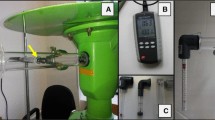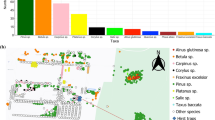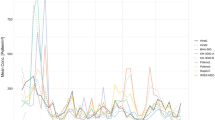Abstract
The Hirst-type pollen trap (1952) is the most common device for aerobiological measurements of pollen and fungal spores in ambient air. In the 1960s the in-line flowmeter was removed and studies since then showed considerable variability in the airflow pumped through the instrument when using hand-held rotameters with an internal airflow resistance to adjust flowrates. To avoid this problem, our study compared the variability of airflow rates of Hirst-type traps when using commercially-available low-resistance airflow meters (heat anemometers) at various timescales. Experiments were conducted in Munich (Germany) and Payerne (Switzerland), using 4 different easyFlux® instruments and 6 Hirst-type pollen traps. Measurements were taken on an hourly basis from dawn to dusk at both locations, and in addition at Payerne, weekly observations over a period of one year. When using the common hand-held rotameters (with airflow resistance) the flow was 28.3% lower than with resistance-free flowmeter (i.e., measured 10 L/min which was in reality 12.8 L/min). The coefficient of variation between the four easyFlux® devices ranged from 0.32% to 1.55% over one day and from 2.88% to 8.17% over an entire year. Some of the traps showed surprising flow variations during the day. Furthermore, flowrates deviated more when measurements were made at the point where the double-sided tape is behind the orifice than elsewhere on the drum. The measurements away from this point are representative of the flow rates for most of the period of operation and flow calibration should thus be carried out away from this point, contrary to the current procedure.
Similar content being viewed by others
Avoid common mistakes on your manuscript.
1 Introduction
Air quality plays an important role in human health (Fernández-Rodríguez et al., 2018). Among the different bioaerosols, pollen has substantial impact on human health (de Weger et al., 2013). These allergenic particles are monitored worldwide, with most sites using Hirst-type instruments (Buters et al., 2018). The volumetric samplers use a suction trap in which particles enter through a narrow orifice and impact onto a sticky surface that moves below the orifice at a rate of 2 mm/h (Hirst, 1952). A European standard (EN16868, 2019) was established to describe the sampling procedure and for the calculation of airborne pollen and fungal spore concentrations using this method.
Systematic errors have been detected with Hirst-type traps, notably related to the flowrate which was shown to vary between 5 and 72% across 19 instruments despite having been set to 10 L/min following the European standard using hand-held rotameters (Oteros et al., 2017; Triviño et al., 2023). One way to address this issue is to use a low-resistance flowmeter such as the electronic heatwire easyFlux®, that is able to measure flowrates between 0 and 100 L/min. The flowrate is adjusted for temperature and pressure according to the manufacturers´ information (easyFlux® 2022). This flowmeter was used in a recent study to reduce the variability between four Hirst-type traps by 28.2% for hourly—and by 21.6% for daily average observations (Triviño et al., 2023).
Because our previous study showed a difference between different brands of hand-held rotameters, we evaluated the accuracy of one commercially-available, hand-held heat-wire flowmeter with a low airflow resistance (easyFlux®) and compared the variability in the flow of Hirst-type traps at various timescales at two different sites, namely Munich (Germany) and Payerne (Switzerland).
2 Materials and methods
The experiments were carried out at the Center of Allergy and Environment (ZAUM), located in Munich, Germany (48.16455°N, 11.59321°E), and at the Federal Office of Meteorology and Climatology MeteoSwiss, in Payerne, Switzerland (46.81341°N, 6.94295°E). In Munich, four different electronic Cavazza Ana easyFlux® heat-flowmeters were used to evaluate the flowrates of four Hirst-type traps (Burkard Manufacturing Co. Ltd, Rickmansworth, UK). For Payerne, two EasyFlux® were used to measure the flowrate of two Hirst traps (same brand as in Munich). In both cases, all available easyFlux® flowmeters were simultaneously tested. The Hirst devices were set to have a flowrate of 10 L/min using a hand-held Burkard Manufacturing Co. Ltd (Rickmansworth, UK) flowmeter before starting the experiment, following the standardized procedure (EN16868, 2019). This flowmeter showed a variability in our experiments of 9.8 ± 0.3 L/min (3.1%) (Fig. 1).
Sampling was performed over one day in Payerne and Munich, in both cases during spring 2022 and on a day without rain (10 March and 6 April, respectively). The Hirst-type traps were placed at a distance of 1 m from each other and measurements were taken at the orifice (2 mm × 14 mm). The sampling period was from dawn to dusk in both Munich (from 7:00 to 20:00) and in Payerne (from 8:00 to 20:00).
Furthermore, only in Payerne measurements were made for two Hirst traps with one easyFlux® device over the period of one year on a weekly basis. Measurements were performed at two positions of the drum: (1) in the position where the double-sided tape is behind the orifice and (2) in a position where the double-sided tape is not behind the orifice, before and after changing the drum of the Hirst traps.
The coefficient of variation between the flowmeters was calculated for each measurement and then averaged over the entire day. The same procedure was carried out on the weekly observations to provide an estimate of the annual variability. One heat-wire flowmeter was externally calibrated (ESZ AG calibration & metrology, Munich Germany) to assure accuracy of the measurements. Statistical analyses were performed using R statistical software (R Core Team, 2021) and plots are produced with the ggplot2 plotting package (Wickham, 2016).
3 Results and discussion
The variability between the flowrate measurements is shown in Fig. 2a, which shows observations from all six Hirst traps at the two sites. Overall, there is good agreement between the four easyFlux® devices in Munich, with no significant differences observed if flowrate from the same Hirst trap is measured. Significant differences were found for Hirst 1, Hirst 2, and Hirst 3 only between easyFlux® 2 and easyFlux® 4 (p ≤ 0.05), as well as for Hirst 3 between easyFlux® 3 and easyFlux® 4 (p ≤ 0.01) (Friedman’s test). In Payerne, no significant differences were observed (Student´s T-test). There is, however, clearly more variability in the flowrates for Hirst 2 and Hirst 4, which is likely due to a sudden change in the flowrate observed at 13:00 and/or 14:00 (Fig. 2b). The reason for these differences is unclear. Despite being statistically different, the coefficient of variation (CV %) between the four easyFlux® instruments was limited and ranged from 0.32% to 1.55% across the six Hirst-type traps over the period of one day. The jump in the flowrate observed in Fig. 2b is thus because of the Hirst trap itself. The reasons for this are the intrinsic differences in Hirst traps (Tormo Molina et al., 2013) and the inconsistent flow rate (Oteros et al., 2017), as mentioned earlier.
The top figure shows flowrate variability between four easyFlux® devices tested on six Hirst-type traps at Munich and Payerne. a-f Diurnal variability (from dawn to dusk) of the flowrate measured with different easyFlux® devices and on different Hirst-type traps at the two observation sites. The respective coefficient of variation (CV) is noted at the top of each figure
Although all the Hirst traps were calibrated to 10 L/min using a Burkard Manufacturing hand-held rotameter at the beginning of the experiment, the easyFlux® measurements showed that the actual flowrates were well above this value, as has been observed in previous studies (Oteros et al., 2017; Triviño et al., 2023). For the two most stable Hirst-type traps the flowrate was 28.3% higher when measured with the low resistance flowmeters than compared to the values indicated by the standard hand-held rotameter. The discrepancy in flowrates measured between the Burkard rotameters and the resistance-free easyFlux® flowmeters is likely due to the weakness of the pump in the Hirst-type traps. While the traps do not require strong pumps, weaker (often older) pumps react more to the internal resistance of the hand-held rotameters, which is high compared to the strength of the pumps, than to the low-resistance flowmeters. Interestingly, half of the traps tested here showed a clear shift in flow during the day, two of them even showed a sudden change in flow. Changes in temperature, air pressure, or friction in the motor are possible explanations. This remains, however, to be confirmed with further measurements since the reason for the sudden changes in the observed flow for the traps 2 (a drop in flow) and 4 (an increase in flow) were not obvious. With the stable traps (Hirst 1, 3, 5, 6) the maximum difference in flowrate over a day was observed to range from 13.23 to 14.07 L/min, or 6.0%. In comparison, the measurements from the Burkard rotameters showed a low variability, with a coefficient of variation of 2.8%. However, this slightly higher variability compared to heat-wire anemometers might be due to the fact that manually reading the scale on these devices is not so accurate.
The annual variability of the flowrate and respective coefficients of variation for the two Hirst-type traps located in Payerne are shown in Fig. 3. These results indicate that there is more variability and a lower flowrate when measuring in the position where the double-sided tape is behind the orifice (i.e., when it is in line with the orifice) than when measured when the double-sided tape is not behind the orifice. The coefficient of variation in flow over one year was 2.9–3.1% (ranging from 10.28 to 14.27 L/min) at the tape and from 4.2 to 8.2% away from it. Figure 4 also shows that the flowrate when the double-sided tape is behind the orifice is 12.5 ± 0.8 L/min compared to normal operation when flowrates were observed to be 13.4 ± 0.5 L/min (when the double-sided tape is not behind the orifice). These differences were significant (p < 0.001, Wilcoxon signed-rank test) and indicate that more consistent flowrate values are obtained when measurements are made when the double-sided tape is not behind the orifice. This is an important difference from what is suggested as the standard method (EN16868, 2019), which indicates that flowrate measurements should indeed be made when the tape is behind the orifice.
Flowrates measured for two Hirst-type traps (located in Payerne) with a single easyFlux® device over one year. Two measurements were made each week: one in the position where the double-sided tape is behind the orifice (the calibration position according to the EN16868 standard) and one in a position where the double-sided tape is not behind the orifice. For both measurements, the CV (Coefficient of Variation) is indicated in the text box
Flowrate variability of the two Hirst-type pollen traps measured with one easyFlux® device. Values were taken once each week for the period of one year before and after changing the drums, either in the position where the double-sided tape is behind the orifice (red boxes) and in a position where the double-sided tape is not behind the orifice (green boxes)
4 Conclusions
Several Hirst-type traps were set to a flowrate of 10 L/min following the current standard method with a hand-held rotameter, which has an internal airflow resistance. Low-resistance easyFlux® flowmeters (anemometers) were then used to measure the flowrates on two different timescales: on an hourly-basis over the period of one day and on a weekly-basis over the period of one year. We showed that the flowrates measured by four different easyFlux® devices varied insignificantly but recorded higher values than the rotameters, as was reported previously (Oteros et al., 2017; Triviño et al., 2023). The flowrates were also shown to vary from 0.32 to 1.55% over the course of a day (from dawn to dusk), while over one year they varied considerably more, ranging from 2.88 to 8.17%. In addition, the results showed that flowrates should be measured when the double-sided tape (that fixes the Melinex tape to the drum) is not behind the orifice. In all cases, given the pressure drop that rotameters induce, we recommend the use of low-resistance flowmeters.
References
Buters, J. T. M., Antunes, C., Galveias, A., Bergmann, K. C., Thibaudon, M., Galán, C., Schmidt-Weber, C., & Oteros, J. (2018). Pollen and spore monitoring in the world. Clinical and Translational Allergy, 8(1), 1–5. https://doi.org/10.1186/s13601-018-0197-8
de Weger, L. A., Bergmann, K. C., Rantio-Lehtimäki, A., Dahl, A., Buters, J., Déchamp, C., Belmonte, J., Thibaudon, M., Cecchi, L., Besancenot, J. P., Galán, C., & Waisel, Y. (2013). Impact of pollen. Allergenic Pollen: A Review of the Production, Release, Distribution and Health Impacts. https://doi.org/10.1007/978-94-007-4881-1_6
EasyFlux, (2022). “EasyFlux | EasySPT.” Retrieved May 28, 2022, from https://www.easyspt.com/shop/easyflux/
EN16868, (2019). EN16868 (2019). Ambient air-sampling and analysis of airborne pollen grains and fungal spores for networks related to allergy-volumetric hirst method. European Standards.
Fernández-Rodríguez, S., Cortés-Pérez, J. P., Muriel, P. P., Tormo-Molina, R., & Maya-Manzano, J. M. (2018). Environmental impact assessment of pinaceae airborne pollen and green infrastructure using BIM. Automation in Construction, 96, 494–507. https://doi.org/10.1016/J.AUTCON.2018.10.011
Hirst, J. M. (1952). An Automatic Volumetric Spore trap. Annals of Applied Biology, 39(2), 257–265. https://doi.org/10.1111/J.1744-7348.1952.TB00904.X
Oteros, J., Buters, J., Laven, G., Röseler, S., Wachter, R., Schmidt-Weber, C., & Hofmann, F. (2017). Errors in determining the flow rate of hirst-type pollen traps. Aerobiologia, 33(2), 201–210. https://doi.org/10.1007/s10453-016-9467-x
R Core Team. (2021). R: A language and environment for statistical computing.
Tormo Molina, R., Maya Manzano, J. M., Fernández Rodríguez, S., Gonzalo Garijo, A., & Silva, P. I. (2013). Influence of environmental factor son measurements with hirst spore traps. Grana, 52(1), 59–70. https://doi.org/10.1080/00173134.2012.718359
Triviño, M. M., Maya-Manzano, J. M., Tummon, F., Clot B., Schmidt-Weber, C., & Buters, J. (2023). “Resistance free flow adjustment of Hirst-Type pollen traps reduces variability between traps.” Aerobiologia (submitted).
Wickham, H. (2016). “Ggplot2: Elegant graphics for data analysis. New York: Springer-Verlag.” Retrieved May 28, 2022, from https://ggplot2.tidyverse.org
Acknowledgements
This paper is a contribution to the EUMETNET AutoPollen Programme, which is developing a prototype automatic pollen monitoring network in Europe covering all aspects of the information chain from measurements through to communicating information to the public. We also thank financial support to the COST ADOPT action CA18226 – New approaches in detection of pathogens and aeroallergens. Finally, M.S.S thanks the Internal mobility program for doctoral students of the International Doctoral School (EINDOC) of the Thecnical University of Cartagena (UPCT).
Funding
Open Access funding enabled and organized by Projekt DEAL.
Author information
Authors and Affiliations
Contributions
M.S.S (equal), C.S (equal) and G.M.J (equal) carried out the data collection and perform the experiments. M.S.S. (lead), J.M.M. (equal), F.T. (equal), J.B. (equal) and B.C. (equal) wrote the main manuscript. M.S.S. (lead), J.M.M. (equal), F.T. (equal) and J.B. (equal) prepared the figures and tables. M.S.S (equal) and J.M.M (equal) performed the data curation and formal analysis, including visualization and software. F.T. (lead), J.B. (support) and B.C. (lead) obtained the funding acquisition and project administration. J.B (lead), F.T. (equal) and B.C. (equal) supervised the work. All authors reviewed and edited the manuscript.
Corresponding author
Ethics declarations
Conflict of interest
The authors have no relevant financial or non-financial interests to disclose.
Rights and permissions
Open Access This article is licensed under a Creative Commons Attribution 4.0 International License, which permits use, sharing, adaptation, distribution and reproduction in any medium or format, as long as you give appropriate credit to the original author(s) and the source, provide a link to the Creative Commons licence, and indicate if changes were made. The images or other third party material in this article are included in the article's Creative Commons licence, unless indicated otherwise in a credit line to the material. If material is not included in the article's Creative Commons licence and your intended use is not permitted by statutory regulation or exceeds the permitted use, you will need to obtain permission directly from the copyright holder. To view a copy of this licence, visit http://creativecommons.org/licenses/by/4.0/.
About this article
Cite this article
Suarez-Suarez, M., Maya-Manzano, J.M., Clot, B. et al. Accuracy of a hand-held resistance-free flowmeters for flow adjustments of Hirst-Type pollen traps. Aerobiologia 39, 143–148 (2023). https://doi.org/10.1007/s10453-023-09782-x
Received:
Accepted:
Published:
Issue Date:
DOI: https://doi.org/10.1007/s10453-023-09782-x








